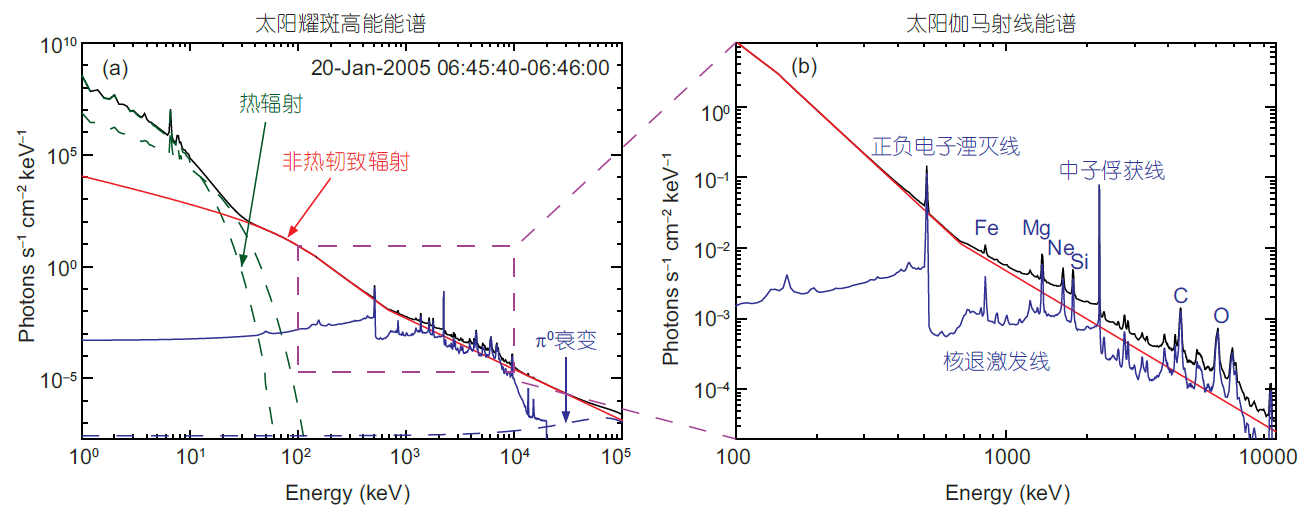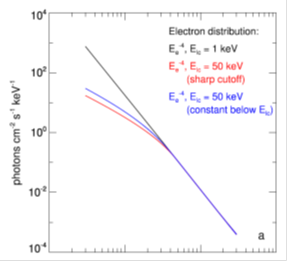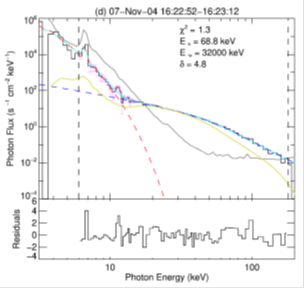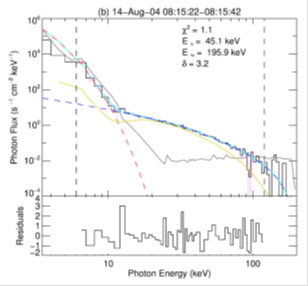New Research Revealed Energy Cutoffs in Flare-Accelerated Electrons
Flares are violent explosions in solar atmosphere, one of the origins of hazardous space weather, and also natural particle accelerators. Tremendous number of electrons can be accelerated to energies of more than tens of MeV in a short time, and protons to 10 GeV. These particles cause a series of effects and release intense X-ray and Gamma ray emissions (Fig. 1). They are one of the key factors in energy release and distribution of flares.

Fig. 1 Typical high energy spectra observed in a X7-class flare. (Image by SU Yang)
An international team from Purple Mountain Observatory, Peking University, and Leibniz-Institut für Astrophysik Potsdam (Germany) studied the X-ray and SEP (solar energetic particles) observations and confirmed the existence of low and high energy cutoffs that are caused by the acceleration process in flares. The results provide important new clues and constraints for understanding the high energy spectra, acceleration and transportation of flare electrons. They will also help to understand aurora, TGFs (Terrestrial gamma-ray flashes), and other high energy astrophysical activities.
High and low energy cutoffs define the upper and lower limits of accelerated electrons. They are important parameters in understanding particle acceleration and energy distribution. The low-energy cutoff in particular is a key parameter that determines the total number and energy of energetic electrons. It leads to significant flattening of X-ray spectra below the cutoff energy, with a spectral index as low as ~1.3. It is a special type of double power-law spectra with large spectral breaks (Fig. 2). But in most cases, the low energy end of X-ray spectrum is dominated by the thermal emission from plasma with a temperature as high as tens of MK. Therefore, the feature usually appears as normal double power-law, making it difficult to determine its true origin from a number of processes, such as albedo effects, return current energy losses, super-thermal components, pulse pile-up effects, and so on.
Therefore, it is still a question whether low-energy cutoff caused by acceleration really exists, and even the necessity of low-energy cutoff is also questionable. Some researchers believe that low-energy cutoff is only needed in calculations and energy estimation, but not a physical parameter in acceleration.
Considering these problems, the research team studied the energy cutoffs from two specific aspects. They studied a special group of flares with high low-energy cutoffs and low thermal emission and found the full spectral feature of low-energy cutoff in X-ray spectra. Moreover, they also gave the consistent low and high energy cutoffs in both X-ray spectra and SEP electron distribution. The former is emitted from electrons propagating down along flare loops, and the latter is the direct measurement of electrons escaping from flares into interplanetary space (excluding CME-accelerated electrons), both from the same origin. In previous works, the study was focused on the index of electron’s power-low distributions using X-ray and SEP data. Besides, the research team analyzed in detail the impacts of high energy cutoff on X-ray spectral shapes (Fig. 2) and emphasized the importance of this factor.



Fig. 2 The left panel presents X-ray spectra emitted from a single power-law, and two power-law electron distributions with low energy cutoffs, respectively; the middle and right panels show the observed RHESSI spectra and spectral fitting results. They reveal full spectral feature of low energy cutoff. (Image by XIA Fanxiaoyu and SU Yang)
This work, corresponded by Professor SU Yang, is a part of the scientific preparation research for the HXI payload onboard of the Chinese solar mission ASO-S, and is mainly supported by the National Natural Science Foundation of China, the CAS Strategic Pioneer Program on Space Science, and German Space Agency DLR. The paper has been published in The Astrophysical Journal recently.